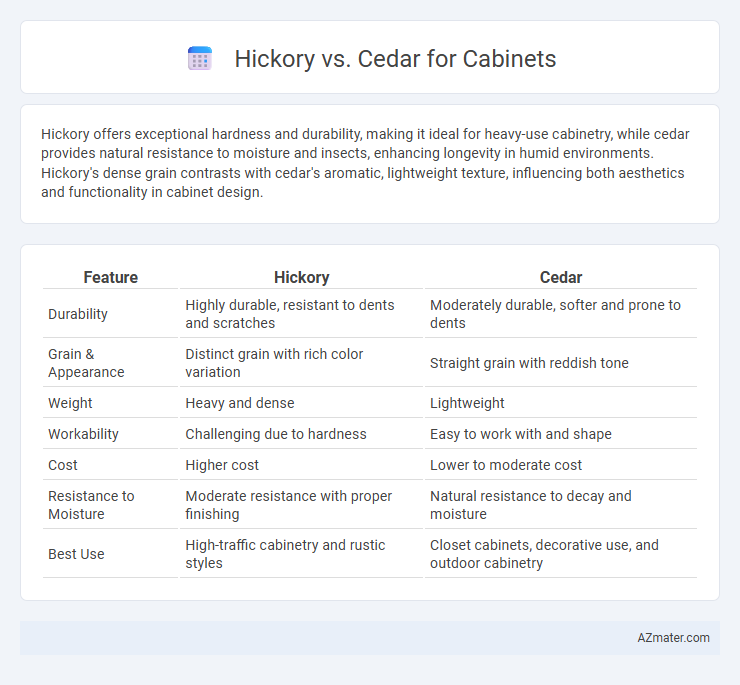Hickory offers exceptional hardness and durability, making it ideal for heavy-use cabinetry, while cedar provides natural resistance to moisture and insects, enhancing longevity in humid environments. Hickory's dense grain contrasts with cedar's aromatic, lightweight texture, influencing both aesthetics and functionality in cabinet design.
Table of Comparison
| Feature | Hickory | Cedar |
|---|---|---|
| Durability | Highly durable, resistant to dents and scratches | Moderately durable, softer and prone to dents |
| Grain & Appearance | Distinct grain with rich color variation | Straight grain with reddish tone |
| Weight | Heavy and dense | Lightweight |
| Workability | Challenging due to hardness | Easy to work with and shape |
| Cost | Higher cost | Lower to moderate cost |
| Resistance to Moisture | Moderate resistance with proper finishing | Natural resistance to decay and moisture |
| Best Use | High-traffic cabinetry and rustic styles | Closet cabinets, decorative use, and outdoor cabinetry |
Introduction to Hickory and Cedar Cabinets
Hickory cabinets are renowned for their exceptional durability and distinctive grain patterns, making them a popular choice for rustic and traditional kitchen designs. Cedar cabinets offer natural resistance to moisture and insects, coupled with a warm, aromatic quality that enhances the ambiance of any space. Both woods provide unique aesthetic and functional benefits, with hickory delivering strength and character, while cedar emphasizes longevity and natural protection.
Appearance and Grain Patterns
Hickory cabinets feature a strong contrast in grain patterns with a mix of light and dark streaks, creating a rustic and bold appearance ideal for traditional or country-style kitchens. Cedar offers a softer, more uniform grain with reddish hues and a natural aromatic quality, lending warmth and a touch of elegance to cabinetry. The distinct, coarse grain of hickory contrasts sharply with cedar's smoother, fine-grained texture, influencing the overall aesthetic and ambiance of the space.
Durability and Strength Comparison
Hickory offers superior durability and strength compared to cedar, making it ideal for high-traffic cabinetry due to its dense, hard grain that resists dents and scratches. Cedar, while softer and less durable, provides natural resistance to moisture and decay, beneficial in humid environments but less suited for heavy use. For cabinetry that demands long-lasting structural integrity and toughness, hickory is the preferred choice.
Resistance to Moisture and Decay
Hickory offers moderate resistance to moisture and decay, making it suitable for cabinetry in low-humidity areas but may require additional sealing in moist environments. Cedar exhibits superior natural resistance to moisture and decay due to its high content of natural oils and tannins, enhancing durability in humid or damp conditions. Choosing cedar over hickory results in longer-lasting cabinets with less frequent maintenance when exposed to moisture.
Cost and Value Differences
Hickory cabinets generally cost more than cedar due to their dense grain and higher durability, making them a premium choice for long-lasting cabinetry. Cedar offers a more affordable option with natural resistance to moisture and insect damage, providing excellent value for budget-conscious homeowners. While hickory's hardness ensures superior wear resistance, cedar's aromatic properties and lighter weight contribute to its distinct appeal in cost-sensitive applications.
Maintenance and Care Requirements
Hickory cabinets require regular sealing or finishing to prevent moisture absorption and maintain durability, as they are prone to scratches and dents due to their hardness. Cedar cabinets naturally resist insects and mold, reducing maintenance needs, but they benefit from occasional oiling to preserve their aromatic properties and prevent drying or cracking. Both woods demand periodic cleaning with mild, non-abrasive products, but cedar's inherent resistance lowers the frequency and intensity of upkeep compared to hickory.
Environmental Impact and Sustainability
Hickory cabinets are often sourced from sustainably managed hardwood forests, offering a durable and long-lasting option that reduces the need for frequent replacement. Cedar, known for its natural pest resistance and slow growth rate, provides an eco-friendly choice with inherent durability that minimizes chemical treatments. Both woods contribute to sustainable cabinet production when harvested responsibly, but cedar's natural resistance may lower environmental impact by decreasing the reliance on synthetic finishes and preservatives.
Best Uses for Hickory Cabinets
Hickory cabinets excel in high-traffic kitchen areas due to their exceptional durability and resistance to dents and scratches. Their distinct grain patterns and warm, natural tones make them ideal for rustic, farmhouse, or traditional kitchen designs that emphasize character and texture. Hickory wood's density also supports heavy hardware and frequent use, ensuring long-lasting performance in busy household environments.
Best Uses for Cedar Cabinets
Cedar cabinets are ideal for environments prone to moisture due to their natural resistance to decay and insect damage, making them perfect for kitchens and bathrooms. The aromatic properties of cedar also help repel pests and add a subtle fragrance, enhancing the cabinet's practical and aesthetic value. Compared to Hickory, which is harder and more durable, cedar offers superior dimensional stability and a softer, warm appearance ideal for rustic or cottage-style cabinetry.
Choosing Between Hickory and Cedar for Your Cabinets
Choosing between hickory and cedar for cabinets involves evaluating durability, aesthetics, and resistance to wear. Hickory wood offers exceptional hardness and strength, making it ideal for high-traffic areas, while cedar provides natural resistance to moisture and insects, contributing to longevity in humid environments. Both woods feature distinct grain patterns and colors, with hickory showcasing bold, contrasting tones and cedar offering a warm, reddish hue that enhances rustic or traditional cabinetry styles.

Infographic: Hickory vs Cedar for Cabinet
 azmater.com
azmater.com